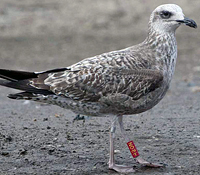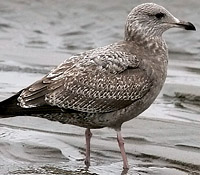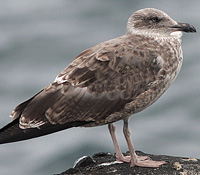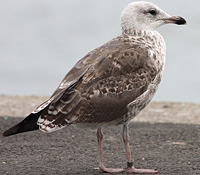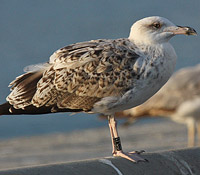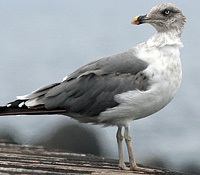 Atlantic Yellow-legged Gull (atlantis)
Atlantic Yellow-legged Gull (atlantis)
(last update: October 12, 2011)
Atlantic YLG 1cy November
Atlantic Islands Yellow-legged Gulls: an identification gallery
Philippe Dubois (France)
IN: BIRDING WORLD, Vol 14 No 7
BELOW: PART II
First-winters
I have no personal experience of this plumage but, from photographs taken in winter in the Azores, it seems that juveniles have a protracted post-juvenile moult and retain much juvenile plumage through their first-winter, much like some graellsii/intermedius and smithsonianus (eg Howell et al. 1999 & Howell 2001) or Kelp Gull (Jiguet et al. 2001). Thus most of the plumage is still juvenile in winter, but the head and breast are bleached whiter, and the scapulars may be mainly fresh, first-winter ones. First-winters collected on the Azores in February and preserved at the MNHN (Paris) are still in mostly juvenile plumage (though very worn and abraded), with a few new scapulars, however. Many first-winters on Madeira acquire wholly second generation scapulars by April (M. Ahmad, pers. com.); those on the Canary Islands seem to be similar, but show a more extensive body moult by January (B. Small, pers. com.).
First-summers / second-winters
The most important characteristic of birds in their first-summer is that many, at least in the Azores, have not finished their second partial moult (and even their post-juvenile moult?). Indeed, it is not always easy to distinguish between juveniles and first-summers at a glance. As mentioned by Howell (2001), they may even moult directly to ‘second-winter’ plumage (see Plates 15 to 18 in PDF).
In the Azores, most birds in their first summer appear juvenile-like in plumage (albeit worn and faded). The scapulars, some greater coverts and tertials have been moulted, and these second generation feathers are dark brown, not grey. They look very dark and typically recall some first-summer smithsonianus. The underparts are also still very dark in many birds, although some can show a whitish breast, Flanks and belly, speckled with dark streaks.
ln the Canarian birds, most of the dark markings on the head and underparts wear off and they then recall nominate michahellis of the same age, although the demarcation between the new grey mantle feathers and the darkly marked coverts is generally less pronounced. Sometimes they have very few new grey feathers on the mantle, and simply largely retain barred feathers on the upperparts.
In flight, the upperwing pattern is very similar to that of juveniles/first-winters, although in
July-September, many birds are moulting outer primaries and secondaries. The underwing, in the majority of birds, also remains smoky grey-brown as in juveniles/first-winters (apparently in all the populations), and appears darker than in nominate michahellis of the same age. The tail also retains the broad black terminal bar of juveniles/first-winters, with the outermost feathers tending to be more notched with white, while the rump generally has fewer black bars. The bill remains mainly black, with some pink or yellow tones at the tip, at the base and on the culmen. Typically, dark markings are retained on the front of the legs and feet, although they may be less obvious than in the juvenile. The iris is often already pale, sometimes very pale like that of the adult; although eye colour is also advanced on Madeiran birds, many nominate michahellis and Canarian birds (B. Small), and graellsii/intermedius of the same age, still have a dark or pale brown eye.
Second-summers / third-winters
Information about this age is scant and sometimes contradictory but, in fact, birds at this stage are variable. At the end of the summer, birds from both the Azores and Canary Islands at least are in an adult-like (’third winter') plumage. The most obvious feature, at least on those from the Azores, is the dense, fine, grey head-streaking, especially around the eyes, but often on the whole head, creating a characteristic hooded effect, very obvious at a distance. No other Western Palaearctic gull normally shows such a pattern, although some subadult nominate michahellis can show quite dense streaking (and even odd argentatus Herring Gulls in late autumn in southern Scandinavia, K.M. Olsen pers. com., or graellsii Lesser Black-backed Gull, although perhaps never as solidly on the ’fore-face').
Most birds show some dark brown or blackish immature-type feathers, mainly in the lesser and median coverts and tertials. In August, most are still moulting both the secondaries and primaries (with at least p7-8 growing and p10 sometimes still old and dark brown). From a single specimen from the Azores at the MNHN (Paris), the new p10 seems to show a white mirror, so moulted third-winters should show a white mirror. From below, on many, the underwing still shows a broad dark bar across the rear part of remiges, recalling Lesser Black-backed Gull. The tail generally has only a few black spots at the tip, but beware of individual variations: some birds at this age can still show a broad black tail-band. From the evidence of birds in near-adult plumage, it is suggested that the complete post-breeding moult starts earlier in the season than in nominate michahellis, so birds seen at the end of the summer are already in ’third-winter’ plumage (although still actively moulting their outer remiges).
The iris is normally already very pale, often whitish-yellow just as in the adults, and, since the head is dark, it stands out well. On the Azores birds, the bill is normally tri-coloured, unlike nominate michahellis: the base is generally pink with some small blackish marks, the tip is yellow or orange-yellow (also with some blackish markings) and the middle is black, forming a more or less broad subterminal band. In Canarian birds, the bill is adult-like, though also variable and with some traces of black near the gonys red spot. The legs are pale yellow, sometimes with just subtle dark markings retained on the front of the tarsi.
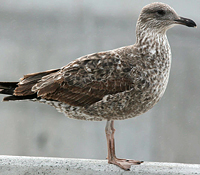
.jpg)
